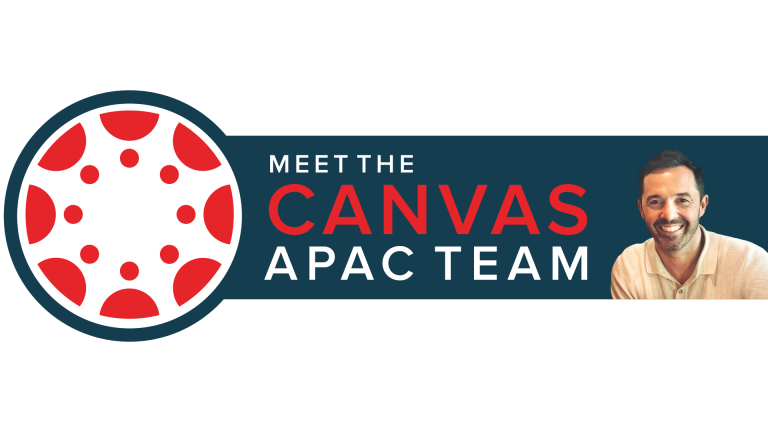
In our Meet the APAC Team series, we’re introducing you to the people in our region who are making things happen. We hope you enjoy getting to know the people behind Canvas!
Some people know exactly what they want to be when they grow up…
…and then there is Adam Ware.
Adam's path to becoming a Senior Customer Success Manager (CSM) has been anything but linear. But as the adage says, “life is what happens when you're busy making other plans.” For Adam, who's now based in Singapore, those plans led him to a career where he could make a real difference in the lives of educators, business owners and learners.
With a background in senior management, edtech, and financial services, Adam brings a unique perspective to the role. He understands the challenges that vocational institutions face, and he's passionate about helping them leverage the power of the Instructure Learning Ecosystem to achieve their goals.
Discover what makes Adam tick, what drives him, and how his unconventional journey has shaped him into the successful CSM he is today.
What drew you to edtech, and specifically to Instructure?
Honestly, I fell into this industry twice. My first foray was in the financial services sector through Tribeca, which later became Kaplan. Almost 10 years to the day, I was reskilling and pivoting for a different career when a current colleague praised Instructure and that they were hiring.
The APAC team vibes at the time were very much startup, dynamic and agility ruled the day. But it instantly felt welcoming and after almost seven years here, it still feels that way, even though we’ve matured across the region.
Before joining, I’d run a design and digital marketing studio, was a director of my own company, worked in a payroll startup and had experience across e-commerce, and hospitality management—sounds like a lot when I look back. I’ve enjoyed turning that knowledge and experience into valuable insights and ultimately helping my customers.
Can you share a recent customer success story that made you proud?
I'm most proud of the businesses that transitioned online during COVID. In the vocational ed, RTO, and further ed sectors, the transitions were initially out of necessity and livelihood. Post this global shift, I’ve had multiple customers grow significantly from the framework laid in a time of uncertainty.
They recognised the change in the world and embraced the challenge head-on. They’re in a much stronger position now than those that shifted online because they felt they had to and who never really explored the new opportunities that were available.
How do you think the Instructure ecosystem differs from traditional product solutions?
When I first started, there wasn't an ecosystem; we had products but we also had gaps. When I look at today’s “lifelong learning” approach, it's less about the functionality of each product. We start with what the customer wants to achieve and how we can help them—and then we tap into the ecosystem for functionality.
With an ecosystem, the ability for you to change and be agile within a certain timeframe is easier. Canvas LMS at the core allows for unparalleled flexibility. You could literally set up overnight and start your business as soon as your content’s finished. It’s pretty amazing to be able to do that with one system, one CSM, and one team. It takes all the confusion out.
What's the most interesting challenge you've helped a customer solve recently?
I’ve always enjoyed challenging a client's status quo and capacity for change. I’m never one to shy away from change, especially when the answer could unlock potential business success and return on investment.
I’m really enjoying working with Intelligent Insight customers with the “Ask Your Data” functionality. Providing technical insights through plain language queries is a great way to accelerate a business’s understanding of usage, participation, and engagement without the need for large, complex, and expensive technical builds.
What does "trusted partner" mean to you in the edtech context?
Listening to our customers and spending time understanding their challenges and goals.
For instance, my clients will ask, “Can you tell me what other customers are doing?” But what they’re doing isn’t necessarily going to solve your problem without detailed context.
Instead, I focus on what my client is actually trying to do. Similarly, when a client says, “We want to do X and we want to do it this way,” I always ask, “Why this way? Have you thought about this way which will also assist us here, here and here.”
Often, the biggest challenge is unlocking the conscious mind to think differently. I help break down those barriers while understanding the client, the resources, and the direction they want to go in, whilst being aligned to their goals.
To be partners, you need to go through a test with each other and grow from that. With their best interests at heart and looking at it from a place they can’t quite see yet, you become a trusted confidant, because they know you’re navigating the waters with them.
What's the best piece of professional advice you've ever received?
I don’t have a particular piece of professional advice but the current quote on my wall (yes, I’m a quote guy) is from Dr Michael Gervais, an elite-level sports coach, that goes, “As humans, we can only train three things: our craft, our bodies, and our minds.”
I use it to bring things back into focus and also ensure I don’t rest on what I did yesterday. Life is a mix of what we’ve done, what we’re doing, and what we want to do.
How do you recharge and stay motivated?
I look to get outdoors and away from distractions. I’m constantly AWOL in my free time with the blessing of my beautiful wife. To be my best self, I need to be selfish with my time when I get it.
I’ve never needed motivation since becoming a dad. Every minute of every day, there is a reason to be better because you’re being watched and, subconsciously, your child is picking up what you’re doing. They are a by-product of what you do, not what you are.
How do you see technology transforming education in the next 10 years?
I think flexibility, availability, and quality within a customer-focused UX will be key to capitalising on education, regardless of your market. We’ve seen the traditional education journey change significantly and the value of what it delivers being challenged. As the generation who’ve had digital technology from birth mature into decision makers, they will expect convenience, knowledge, and immediate information within the palm of their hand.
The government-led “skills passports” initiatives will see a massive shift to gaining and sharing accredited skills. I also see some standards being aligned across countries or regions too.
My ultimate question is are governments and regulatory bodies up to the challenge of evolving with the needs of learners and the technology available?
We’ve talked a lot about the Instructure ecosystem. What aspect of it are you most excited about?
From a teaching and learning standpoint, I’ve always enjoyed Canvas Studio. It’s one of the easiest ways to drive engagement and participation through convenience and break up content monotony.
It also encourages the adoption of the Canvas Mobile Apps for easier student recording and submission, leading to overall better adoption. At the same time, you’re teaching a user how to use and embrace technology—a life skill required in the modern day.
But I’m also excited by some things I saw at kick-off earlier this year. I’ll leave that surprise for later.
What's your best advice for an organisation that's either looking to implement Canvas or wants to better use their instance?
I usually start with asking, “What is your institution's vision for teaching and learning?” It has nothing to do with technology. I want to understand where you are now, and where you need to go, and then provide insight to achieve where we want to be, and how functionality, workflows, and processes will be aligned to that direction.
It’s important to have executive leadership and ambassadors in alignment because then you’re in a position to move together collectively. If you come to me with an idea already in place, we can move very fast, but the biggest thief of time and joy is when you don’t already have that alignment in place.
Any final thoughts?
Every CSM is a coach: you’re the trusted confidant, you play the political advisor, you become part of the furniture. We want you to drive adoption, so it’s our job to be intrinsically invested in your organisation and support the way you do things. If you succeed, we succeed.
Connect with Adam on LinkedIn.


